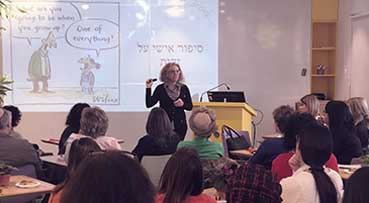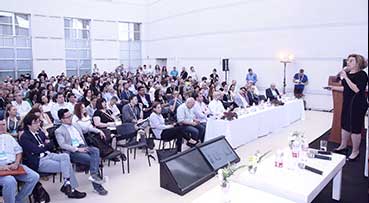As we stand on the brink of unprecedented transformations, recognizing and understanding the mega trends shaping people strategies becomes more important than ever. The organizational blueprint of tomorrow demands more than just a willingness to adapt; it necessitates a proactive approach to embrace and architect change, focusing on human-centric and technologically enriched environments. This cheat sheet serves as a navigational compass for leaders and HR visionaries to proactively decipher and integrate the mega trends shaping our work realities, forging paths that are not only progressive but also sustainable and humane.
1. Management: From Authority to Influence
Current Landscape: We find ourselves in a predominantly hierarchical era where management principally equates to formal authority within organizational structures. However, the seeds of change are germinating. Individuals are emerging whose influence is escalating due to their roles as central resources for knowledge, direction, and various needs, spanning both professional matters and personal issues.
Future Approach: Managers will guide work and/or people through complex systems amid uncertainty, acknowledging that they do not possess all the answers. Their role will evolve to mobilize individuals and facilitate the right questions. They will employ relational tools to empower achievement and cultivate flourishing teams while aligning organizational objectives with personal goals.
2024 People Strategy: Reorient management programs to minimize control and maximize leverage and influence.
2. Structures: From Centralized Hierarchy to Distributed Network
Current Landscape: The concept of an organization as a mechanism solely to execute top-down decisions is long obsolete. In many instances, we already observe horizontally structured teams operating with escalating autonomy. Yet, attempts to manage this network persist through means of control, rather than broadening the frameworks enabling independent, field-level decision-making.
Future Approach: Organizations will transition into networks of interconnected teams, each aligning with the expansive organizational vision. As proficiency in generating data-driven insights is developed, relinquishing control and fostering a culture of trust can be achieved, allowing for decentralized decisions and harnessing collective intelligence.
2024 People Strategy: Formulate a business strategy that is adaptable to the operations of horizontal teams with distributed management.
3. Occupation: From Jobs to Tasks
Current Landscape: Organizations are increasingly acknowledging the constraints of overly rigid roles and explicit promotion ladders, driven by both the organization’s need for adaptability and individuals’ desire for development. There is widespread dialogue about lateral mobility, project-based work, and even internal freelance systems, allowing both the organization and its people greater flexibility. This approach emphasizes skills, learning capacity, and potential, even as we attempt to maintain a focus on clear roles and job descriptions.
Future Approach: Roles will become fluid, with a focus shifting to leveraging a diverse skill set based on project requirements rather than fixed titles. It appears organizations will increasingly hire based on skills and cultural fit as opposed to predefined roles. Teams will be assembled project-by-project, with individuals assuming responsibilities aligned with their strengths and project needs. Structuring work around tasks will also allow for the inclusion of individuals outside the organization, enabling the retention of knowledge from retirees desiring partial employment and “slashers” who work multiple jobs simultaneously.
2024 People Strategy: Identify tasks that can be assigned independently of specific positions and open them for internal recruitment across the organization.
4. Resources: From Locally Owned to Unlimited Sharing
Current Landscape: For several years, we’ve witnessed the emergence of new work modalities—people working irrespective of geographical constraints and often outside traditional employer-employee frameworks. The advent and normalization of remote work tools have demonstrated that talent is not geographically bound. We can locate and engage the right individuals in manners mutually beneficial.
Future Approach: The concept of a centralized office will continue to wane. Collaborative ecosystems will enable borderless cooperation, leveraging the extensive diversity, specialized expertise, and varied perspectives that the democratization of workforces avails. Advanced tools will facilitate immersive meetings, brainstorming sessions, and team-building activities. The definition of “office space” will be reimagined, with digital collaboration platforms emerging as the new-era office, bridging people across different timelines and locations.
2024 People Strategy: Identify an operational area within the organization that can experiment with work beyond conventional structures, incorporating external contributors like slashers, part-timers, or even individuals in different geographical locations.
5. People: From Professions to Skills
Current Landscape: There’s a growing realization that an individual’s ability to learn new skills is becoming more crucial than the knowledge acquired in past roles. However, aligning people and work based on skills proves challenging, leading to a continued reliance on restrictive definitions of education and prior experience.
Future Approach: People will be aligned with the organization, and specifically to work projects, from within and externally, with an enhanced focus on matching capabilities. Development programs will prioritize skill enhancement, perpetual learning, and adaptability.
2024 People Strategy: Rather than stipulating prerequisites in terms of profession and prior experience for staffing and recruitment, endeavor to establish criteria centered around skills and abilities, prioritizing these in the selection process.
6. Learning: From Activity to a Way of Life
Current Landscape: Despite recognizing that learning needs to transition from being an occasional prerequisite to a perpetual necessity, there’s still a significant reliance on formal education, offering professional training as and when needed, typically during periods of role and tool transitions. We’ve been emphasizing the importance of learning, but concurrently, we continue to assess individuals based on work outputs, not rewarding them for allocating time to acquire the knowledge needed for future productivity.
Future Approach: Learning will be so intricately interwoven with professional life that the boundaries between work and learning will increasingly blur. The scope of learning will expand to include not only the acquisition of new skills but also the ability to relinquish outdated methodologies and embrace new ones. Advanced real-time learning tools will provide guidance and coaching, even proactively, ensuring we remain ahead of the curve and pertinent in an ever-evolving landscape.
2024 People Strategy: Allocate a learning budget that includes a manager-employee dialogue on developmental interests, without confining the budget strictly to occupational fields, allowing exploration of any subject of interest.
7. Employee Experience: From One Size Fits All to Personalization
Current Landscape: The prevailing employment concept remains “This is how we do things,” shaping our recruitment, employment, rewards, development, and care strategies. The coronavirus pandemic upended this notion, compelling a consideration of individual employee circumstances and necessitating corresponding flexibility. There is a growing desire to tailor work experiences to individual preferences, ambitions, and needs—including role design, work timing and location, and even customization of benefits, training, and career development.
Future Approach: The convergence of increasing workforce diversity and emerging tools will facilitate the expansion of personalization, creating individualized journeys. These range from artificial intelligence-driven learning pathways tailored to individual learning styles to health programs aligned with personal health goals. The ’employee experience’ will mirror consumer-grade personalization, where each interaction is customized based on personal data and preferences.
2024 People Strategy: Enhance the dimension of personal adjustment within your work environment, starting with job design, extending through flexibility in time and place of work, to development budgets and benefits.
8. Careers: From Ladder to Climbing Wall
Current Landscape: Organizations are perceiving a shift in employee expectations from linear career paths, focused on ascending the organizational ladder, to varied career journeys allowing lateral, upward, and even downward transitions. This new paradigm accommodates diverse aspirations and needs, recognizing the generational differences within the workforce.
Future Approach: Organizations will adopt the career climbing wall model, valuing alignment with organizational values and skill matching over traditional hierarchical advancements. This shift will challenge conventional employee retention strategies, fostering an environment where transient, project-based engagements are the norm and reentries are welcomed. The emphasis will transition from retention to the cultivation of mutual value and organizational adaptability.
2024 People Strategy: Reevaluate the organization’s career development policies, removing obstacles to diverse career trajectories and facilitating seamless exits and reentries.
9. Work-Life: From Balance to Holistic Well-being
Current Landscape: In the past, personal well-being was deemed the responsibility of the employee. However, as work transcends physical boundaries and infiltrates personal spaces, the distinction between professional obligations and personal time is becoming indistinct. Organizations are realizing that employee productivity and satisfaction are contingent upon holistic well-being, encompassing physical, mental, emotional, and digital health. Nevertheless, we often confine welfare initiatives to occasional events and health programs.
Future Approach: Holistic well-being will evolve into a fundamental component of organizational culture and strategy, concentrating on creating an environment that enables employees to seamlessly amalgamate work with other life aspects, allowing them to flourish in every conceivable way. We will adapt a work culture that prioritizes the digital, physical, emotional, and mental facets of health, considering family support, stress management, and resilience.
2024 People Strategy: Ensure your well-being strategy incorporates aspects of mental, emotional, familial, and digital health, promoting a culture of holistic well-being.
10. Technology: From Digital Transformation to Human-Machine Symbiosis
Current Landscape: Technology permeates every facet of our lives—from extensive systems and robots to the tools individuals incorporate into their daily routines. Whereas technology was once viewed predominantly as a means of optimization or a substitute for human labor, contemporary narratives emphasize its role as a seamless integrator into every profession, liberating individuals to prioritize activities that align with both personal and organizational objectives.
Future Approach: The boundary between digital and physical dimensions will increasingly blur, heralding an era of fluid collaboration between employees and advanced technologies. This symbiotic relationship will foster a reciprocally beneficial ecosystem, amplifying the capabilities of both humans and machines and enabling unprecedented levels of innovation, productivity, and problem-solving.
2024 People Strategy: Even if the appropriate applications remain unclear, invest in programs that familiarize individuals with emerging AI tools and advocate for the allocation of time and focus for exploration and experimentation.
Embracing these shifts requires more than mere acknowledgment; it demands proactive engagement, an openness to learning, and a willingness to adapt. It’s time we start integrating these insights into our foundational strategies, cultivating an environment that is conducive to growth, innovation, and holistic well-being. By infusing our 2024 plans with adaptive, people-centric approaches, we are not just preparing for the future; we are sculpting it, ensuring the continuous evolution and enrichment of our workplaces, our teams, and ourselves.

![large-AX1A2125-2[1] large-AX1A2125-2[1]](https://niritcohen.com/wp-content/uploads/elementor/thumbs/large-AX1A2125-21-pnzedcs72atx5aeurqytqdiihxixlq02re9mlz805s.jpg)






